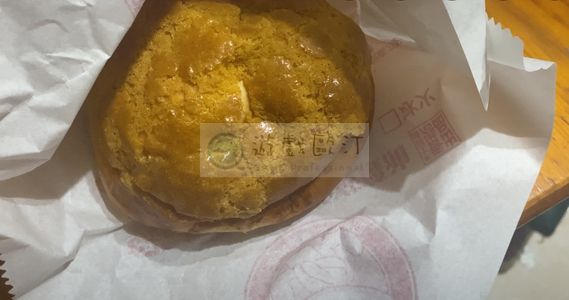波蘿麵包(菠蘿包)的由來與製作
波蘿麵包(菠蘿包)是香港及廣東地區的一款經典甜麵包,外形獨特且口感鬆軟。其名稱來自於其表面脆皮呈現出類似菠蘿的網格狀紋理,儘管實際上這款麵包並不含有菠蘿成分。通常會在港式茶餐廳中出現,成為當地人日常生活中的早餐、下午茶或點心。波蘿包以其甜脆的外皮與柔軟的內部對比,深受各年齡層的喜愛。
歷史可以追溯到20世紀中期,當時香港受到大量西方飲食文化的影響,但也同時保留中式飲食的特色。麵包是由日本、歐洲等地的烘焙技術傳入中國,但經過香港當地的改良後,加入特有的脆皮,使得波蘿包成為一種獨具風味的麵包品種。這種創新性融合東西方的飲食文化,使波蘿包成為香港飲食文化中的象徵性食物之一。
製作波蘿麵包的過程相對複雜,分為兩個主要部分:麵包本體和表面的脆皮。首先,麵包本體的製作通常採用基礎的甜麵包配方。主要材料包括高筋麵粉、酵母、糖、牛奶、雞蛋、黃油和少許鹽。這些材料混合後會經過揉製和發酵,使麵糰膨脹並形成柔軟而蓬鬆的內部結構。揉製麵糰的過程非常關鍵,必須揉至麵糰光滑,並且能拉出薄而有彈性的薄膜,這樣才能在烘焙過程中形成理想的麵包質地。麵糰完成初次發酵後,會被分成小份,再進行二次發酵,這有助於麵包在烘烤時能夠充分膨脹,達到柔軟的效果。接下來,製作波蘿包的特色部分——脆皮。脆皮的主要成分包括低筋麵粉、糖、黃油、雞蛋和少量的泡打粉。這些材料混合在一起後會形成一個柔軟的麵糰。脆皮的關鍵是要達到酥脆的效果,因此低筋麵粉的使用以及材料比例必須精確。在麵包進行二次發酵後,脆皮糰會被切割成小片,並小心地鋪在每個麵糰的頂部。接著,製作出來的波蘿皮會使用刀子或模具在表面壓出菠蘿狀的紋理,這也是波蘿麵包外觀的標誌性特徵。
最後,麵包會被放入預熱的烤箱中,以中等溫度烘烤。烘烤的過程中,脆皮會逐漸變成金黃色,並在麵包膨脹時形成酥脆的表面。而麵包內部則會保持柔軟和濕潤。這種內外口感對比是波蘿麵包最吸引人的地方之一。烘焙完成後的波蘿包外皮酥脆,輕咬下去後,內部的柔軟麵包與香甜的味道讓人回味無窮。雖然波蘿麵包傳統上不含任何餡料,但隨著時代的發展,現代的波蘿包也經過許多變化和創新。有些波蘿包內會加入奶黃、紅豆或奶油等餡料,增添更多口感和風味。此外,一些茶餐廳還推出了「菠蘿油」的變化版,即將一片厚厚的冷牛油夾在剛出爐的波蘿包中,熱麵包融化冷牛油,形成一種鹹甜混合的口感,這也是許多香港本地人的最愛。
總體而言,波蘿麵包是香港飲食文化中的經典代表,通過其簡單卻精緻的製作工藝,展現東西方飲食文化的融合。它既是日常生活中的美味點心,也是香港茶餐廳文化的一部分,伴隨無數人的成長。
The Pineapple Bun (菠蘿包, pronounced "Bolo Bao") is a classic sweet bread popular in Hong Kong and the Guangdong region, known for its unique appearance and soft texture. Its name comes from the crisscross pattern on its crispy top, which resembles the texture of a pineapple, although the bun itself contains no actual pineapple. The Pineapple Bun is commonly served in Hong Kong-style tea houses (茶餐廳) and is a staple for breakfast, afternoon tea, or as a snack. Its appeal lies in the contrast between the crispy, sweet topping and the soft, fluffy interior, making it beloved by people of all ages.
The origin of the Pineapple Bun can be traced back to the mid-20th century when Hong Kong was influenced by Western culinary culture while also preserving Chinese food traditions. Bread-making techniques from Japan and Europe were introduced to China, but local innovations, such as the addition of the distinctive crispy top, gave rise to this uniquely flavored bun. The Pineapple Bun represents a creative fusion of Eastern and Western culinary traditions, becoming a symbolic food in Hong Kong's vibrant food culture.
The process of making Pineapple Buns is relatively complex and consists of two main components: the bread and the crispy topping. First, the bread dough is made using a basic sweet bread recipe. Key ingredients include high-gluten flour, yeast, sugar, milk, eggs, butter, and a pinch of salt. After these ingredients are mixed, the dough is kneaded and left to rise, forming a soft and fluffy structure inside the bun. The kneading process is crucial, as the dough must be worked until it becomes smooth and elastic, capable of forming thin, stretchy membranes to achieve the desired texture during baking. Once the dough has gone through its first proofing, it is divided into small portions and undergoes a second proofing to ensure the buns rise properly during baking, resulting in a soft and airy texture.
The next step is creating the Pineapple Bun’s defining feature—the crispy topping. The topping consists of low-gluten flour, sugar, butter, eggs, and a small amount of baking powder. These ingredients are combined to form a soft dough. Achieving the right level of crispiness is key, and the use of low-gluten flour, along with precise ingredient ratios, ensures the perfect texture. After the dough is proofed for the second time, the crispy dough is cut into small pieces and carefully placed on top of each bun. The top layer is then scored with a knife or patterned using a mold to create the iconic pineapple-like appearance.
Finally, the buns are placed in a preheated oven and baked at a moderate temperature. As they bake, the topping gradually turns a golden brown and forms a crispy shell while the bread inside remains soft and moist. This contrast in texture—crispy on the outside, soft on the inside—is one of the most appealing features of the Pineapple Bun. Once baked, the buns have a crunchy, golden crust, and the soft, slightly sweet interior provides a delightful balance of flavors and textures.
Although the traditional Pineapple Bun contains no filling, modern versions have introduced various innovations. Some buns now include fillings such as custard, red bean paste, or cream to add more layers of flavor and texture. Additionally, many tea houses serve a variation called “Pineapple Butter Bun” (菠蘿油), where a thick slice of cold butter is placed inside the freshly baked bun. The heat from the bun melts the butter, creating a salty-sweet flavor combination that has become a favorite among locals.
In summary, the Pineapple Bun is an iconic representation of Hong Kong's culinary culture, showcasing the fusion of simple yet refined craftsmanship from both Eastern and Western food traditions. It is not only a delicious everyday snack but also a significant part of Hong Kong’s tea house culture, accompanying generations of people throughout their lives.

- 1
- 2
- 3
- 4
